Reference Biography: Walter O’Malley
The Business of Baseball
The fans were uppermost in O’Malley’s thinking and decision-making process. While he ran the Dodger organization in a businesslike fashion, he also appreciated the loyal fans and longtime sponsors, especially Union Oil, Bank of America and Farmer John, who supported the team through thick and thin. There was no increase in ticket prices (ranging from 75 cents to $3.50) from 1958-75 to keep baseball affordable for families, a point quite important to O’Malley. He ordered his front office staff to return all phone calls and letters immediately as part of his complete commitment to fan servicing. O’Malley read and answered every fan letter written to him with help from his able secretary Edith Monak, who worked for him more than 40 years.
“I think they appreciate it because they come out in greater numbers than they do for any other ballpark,” said O’Malley. “Our whole attitude in the Dodger organization is that we want to go first class in everything we do. That’s a little more expensive, but it’s a lot more satisfying to do things the way the public wants them done.” Interview with Geoff Witcher on KABC Radio’s Dodgertalk Show, March 31, 1976
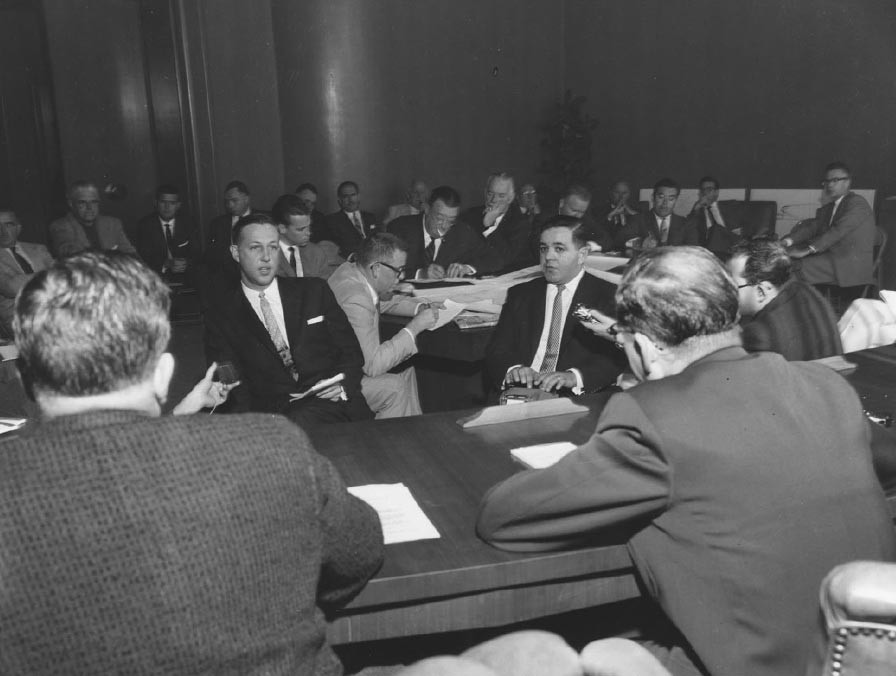
Los Angeles Rams General Manager Pete Rozelle, the future NFL Commissioner, addresses the Coliseum Commission in meetings to discuss the Dodgers’ use of the Los Angeles Memorial Coliseum on January 15, 1958. Meetings became a vital element to the development of Major League Baseball in Los Angeles, cultivating relationships with civic leaders, sponsors and Dodger fans.
Courtesy of University of Southern California, on behalf of the USC Specialized Libraries and Archival Collections
Longtime NFL Commissioner Pete Rozelle, who was General Manager of the Los Angeles Rams when the Dodgers played at the Coliseum, said of Dodger Stadium, “When he built it, he brought a whole new class level to all new sports arenas...I mean a level of service and style and even the dress of the ushers. He showed those that followed how to avoid running a schlep operation.” Jerry Izenberg column, New York Post, August 10, 1979
O’Malley had his stadium ushers wear sport coats, straw hats and a smile. The warm and friendly atmosphere pervaded throughout Dodger Stadium, but unquestionably, it started at the top.
Most longtime baseball observers agree that O’Malley was the most powerful force in the game of baseball. He claimed that the recognition wasn’t anything more than his full-time attention was focused on the sport, where other owners used the game as a secondary business venture.
“I devote all of my time to baseball,” said O’Malley. “Therefore I’m available to serve on more committees than some of the other men who have as their principal occupation their more important and much larger businesses.
“So I’m baseball all the time and if they need someone to go out and pull the weeds or plant a tree, I’ll take a shovel and do it if I have to. It does not necessarily mean that I agree with all the decisions the owners are making.” Associated Press story, June 22, 1968
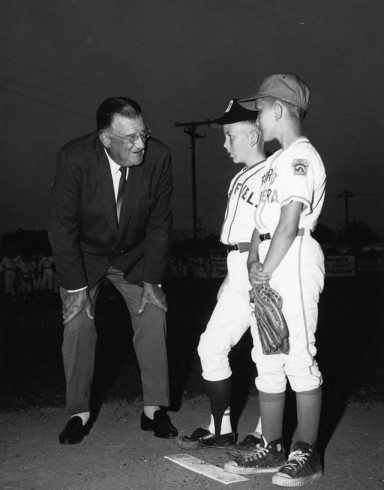
Future Dodgers? Walter O’Malley greets a pair of Little League Baseball players in Vero Beach, FL. O’Malley was a major supporter of the Little League programs, comparing its importance to the Boy Scouts of America. He served on the Board of Trustees for the Little League Baseball Foundation from 1958-79.
He served as a Board Trustee for many years for the Little League Foundation. He once said, “The growth of Little League Baseball is the greatest thing to happen to American youth since the Boy Scouts of America was founded.” Jimmy Powers, New York News, The Powerhouse Column, January 11, 1953 He said, “There is nothing which has been a greater boon to baseball than Little League. If we get our youngsters baseball-minded at that age, we don’t have to worry about them for many years to come. Out of Little League will come our baseball players and our baseball fans of the future.” O’Malley feature, The Bedford Stuyvesant Little League News, Vol. 1, No. 2, July, 1955
From the day they arrived in Los Angeles, O’Malley realized the importance of the diverse marketplace in which the Dodgers played. Long before other sports teams placed games on radio in multiple languages, O’Malley’s Dodgers were the first major league team to offer selected games on radio (WHOM in NY) in Spanish beginning in 1954 with Buck Canel at the microphone. In Los Angeles, all home games and weekend road games were carried in Spanish on KWKW Radio. By 1960 all away games were aired live. The road contests were first re-created and then, in the mid-1970s, the broadcasters traveled with the Dodgers.
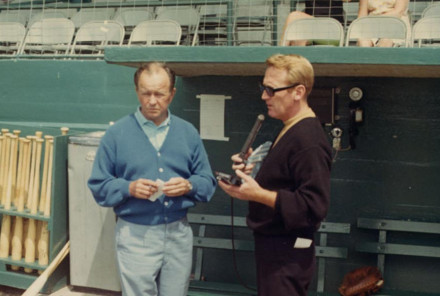
Broadcasters Jerry Doggett and Vin Scully were together in the Dodger booth for 32 years from 1956-87.
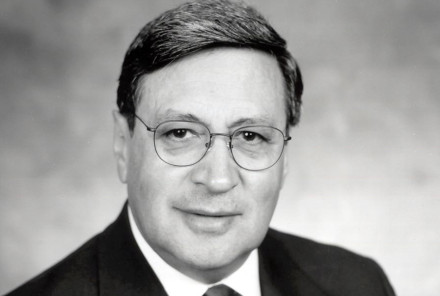
Spanish language broadcaster Jaime Jarrin joined the Dodgers in 1959. He was inducted into the Baseball Hall of Fame in 1998.
English-language radio was thriving with Scully’s unparalleled descriptions and captivating voice, which captured the feel and excitement of each game, providing a storyline that kept fans glued to their transistor radios. Popular Spanish-language broadcaster Jaime Jarrin from Quito, Ecuador arrived on the scene in 1959 and retired after the 2022 regular season and postseason after 64 seasons, providing colorful play-by-play accounts which expanded the interest and listenership in that market to record numbers. Hall of Famer Jarrin broadcast 25 World Series. He broadcast nearly 4,000 games without missing one during a 22-season stretch from 1962-1984. That was interrupted for him to handle all Spanish-language radio coverage and production for the 1984 Games of the XXIII Olympiad in Los Angeles. His longtime partner, Rene Cardenas, of Nicaragua, who helped to establish Dodger games on KWKW Radio in 1958, was Jarrin’s sidekick in the booth for 21 years, serving two tours of duty after leaving the club to formulate the Houston Astros’ Spanish radio network and then returning to L.A. in 1982. In 1977, O’Malley chose popular local KNBC sportscaster Ross Porter to join the Dodger broadcast team. Porter completed 28 seasons with the Dodgers. By winning the Ford C. Frick Award, Scully was inducted into the National Baseball Hall of Fame in 1982, Canel posthumously in 1985 and Jarrin received the same honors in 1998. Three Hall of Famers in the broadcast booth and many more on the field, became hallmarks of the O’Malley era.
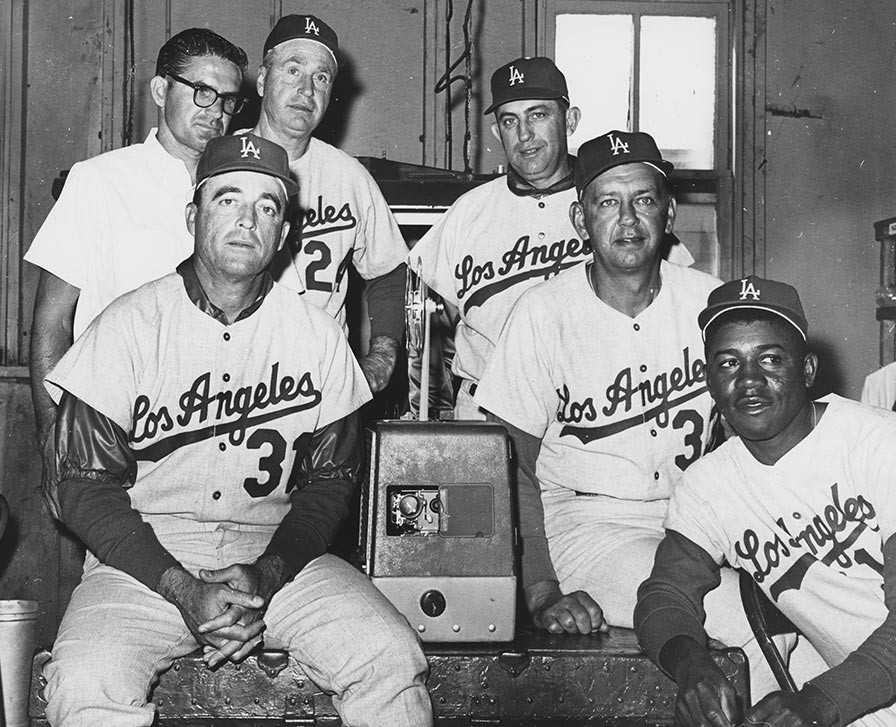
Clockwise: Harold “Lefty” Phillips, pitching coach; Danny Ozark, third base coach; Jim Gilliam, first base coach; Preston Gomez, assistant coach; Bill Buhler, trainer; Walter Alston, Dodger Manager. The 1965 Dodger coaching staff examines film at Dodgertown for their first season and is the first major league team to have two diverse members.
In 1965, O’Malley’s coaches included an African American, Jim Gilliam, and a Cuban, Preston Gomez. Gomez later became a major league manager and scout. When O’Malley’s African-American players were precluded from playing golf in Florida during spring training, he built a nine-hole golf course, the first public course in Vero Beach, on Dodgertown property with equal rights for all. The African-American players were appreciative of O’Malley’s foresight in further breaking down barriers. In 1950, O’Malley was quoted as saying, “People are waking up...prejudices have no place in our society — and certainly not in sports.” The Old Scout column, “Dodger Still Seek Negroes,” October 30, 1950
In 1971, O’Malley expanded his golf interests on Dodgertown property by building the Dodger Pines Country Club, featuring an 18-hole course with a rare par-6 hole which was nearly 667 yards long. “I designed this course myself, from start to finish. I may have made a few mistakes, but this par six wasn’t one of them. I wanted to do something that would make people talk about this course. I wanted a conversation piece. That’s why I went the par six route.” Denis McCarthy, Indian River magazine, “Walter O’Malley’s Golf Musings”, June/July 1976 As a competitive golfer, O’Malley enjoyed getting a group of Dodgers and executives together and relaxing on the links after the baseball work day was done.
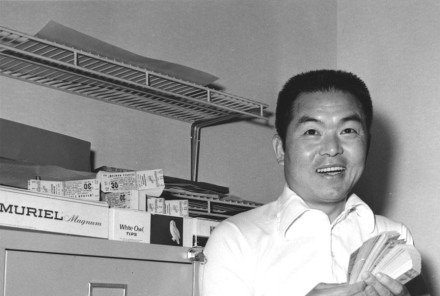
Akihiro “Ike” Ikuhara, a graduate of Waseda University in Japan, working in the Dodger ticket office. Ikuhara learned the business of baseball from the O’Malleys and became a goodwill ambassador and interpreter for the Dodgers. In summer of 2002, Ikuhara was posthumously inducted into the Japan Baseball Hall of Fame.
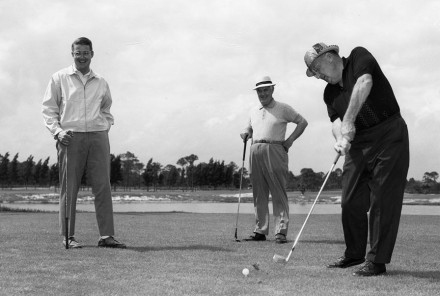
Golf became a passion for Walter O’Malley in the 1960s. The Dodger President hits his tee shot while Peter O’Malley (left) and Vice President Fresco Thompson look on.
A bright, young gentleman, baseball coach and scholar from Waseda University in Tokyo was introduced to the Dodgers by longtime friend and respected author Sotaro Suzuki about working for them. In 1965, O’Malley hired Ike Ikuhara and initially sent him to Spokane, WA to help his son Peter, who was President and General Manager of the Pacific Coast League club. Ikuhara had a thirst for knowledge and O’Malley asked him to learn about the entire organization. He established a broad knowledge of baseball, working in various Dodger departments, including minor leagues, scouting, accounting, ticketing, concessions and public relations. Ikuhara assisted the Dodgers during the team’s 1966 Goodwill Tour to Japan and became a liaison during numerous international visits by the Tokyo Yomiuri Giants to Dodgertown, Vero Beach, Florida in 1967, 1971, 1975 and 1981.
The goodwill ambassador of the Dodgers, Ikuhara represented O’Malley on many international trips and was an integral reason for the success of such outreach with his many contacts. He wrote two books published in Japan, “A Real Pro — Becoming a Major Leaguer” and “Dodger Way — A Winning Tradition.” Ikuhara was named Assistant to Dodger President Peter O’Malley in January 1982. Ten years after he passed away at 55 in 1992, Ikuhara was inducted into the Baseball Museum and Hall of Fame in Tokyo in summer of 2002.
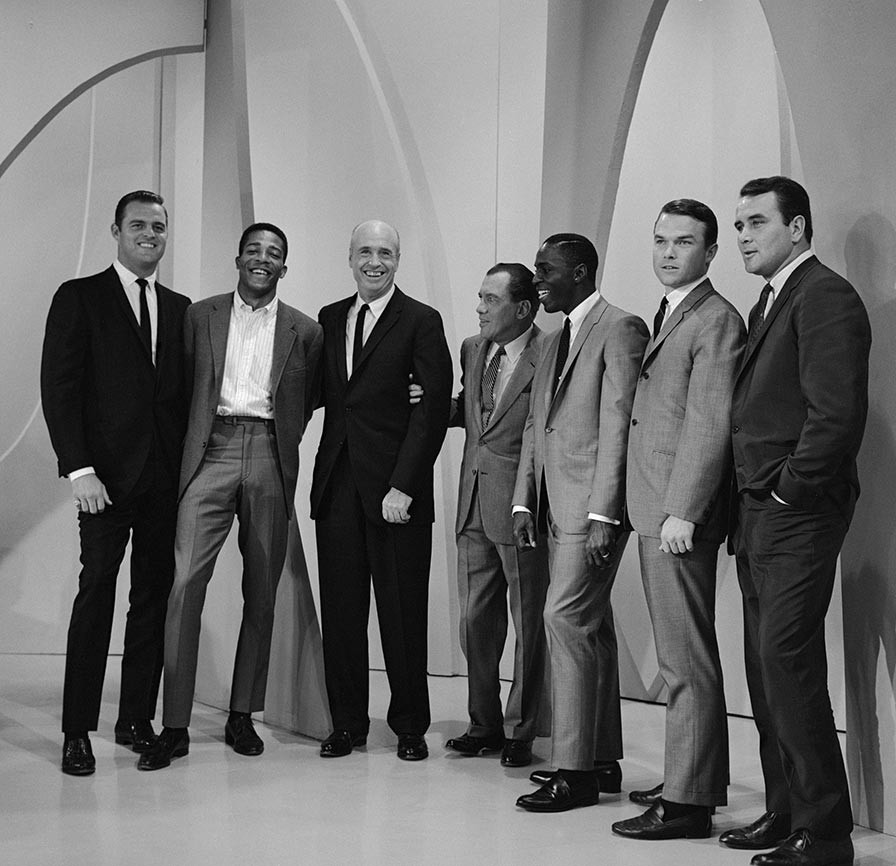
Television host Ed Sullivan (center) greets the 1965 National League Champion Dodgers on October 3. (L-R) Don Drysdale, Willie Davis, Manager Walter Alston, Lou Johnson, Jim Lefebvre and Ron Perranoski. The Dodgers went on to win the 1965 World Series against the Minnesota Twins in seven games.
© Bettman/Corbis
The Dodgers were once again the toast of the town in 1965, as a little known player at the time, “Sweet” Lou Johnson filled in with great success when two-time National League batting champion Tommy Davis broke his ankle and was out for the season. Catalyst Johnson went on a tear and, with the outstanding quality pitching that Dodger teams were known for in that era, they won the N.L. Pennant by two games. Sandy Koufax and Don Drysdale combined to win 49 of the Dodgers’ 97 victories during the regular season. The Dodgers rolled to their third World Championship in seven seasons in Los Angeles, defeating the Minnesota Twins, four games to three, in a seven-game World Series. However, Koufax and Drysdale had a big surprise awaiting boss O’Malley to begin the 1966 season.
Taking time out of his work schedule to relax a little, O’Malley was asked to play a bit part on an episode of the popular “Branded” TV series, starring former Dodger player Chuck Connors. O’Malley played a doctor, Doc Woods (the same name as the actual Dodger team doctor) on the episode, “Bar Sinister,” which first aired on October 10, 1965. O’Malley had invited actor Connors to recite “Casey at the Bat” at the Bohemian Grove to entertain some friends. Connors said he would do it, but only if O’Malley would play a part in the western show. O’Malley was paid $300 for his time, but donated the check to the Motion Picture Relief Fund. O’Malley joked of his two-minute appearance, “That’s just the figure I signed Connors for in ’49. Three hundred dollars a month.”
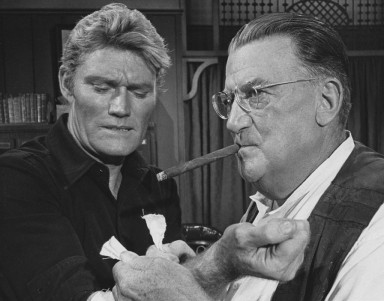
Walter O’Malley made a cameo appearance as a doctor (Dr. Woods) on the television program “Branded,” which starred former Dodger minor league prospect Chuck Connors. The “Bar Sinister” episode initially aired on Oct. 10, 1965.
Also in October of 1965, O’Malley and California Angels’ President Robert O. Reynolds proposed sweeping changes for the Office of the Commissioner, including the establishment of front office staff positions — administrator, deputy commissioner for player affairs, secretary for broadcasting, secretary for public information and secretary for amateur baseball. It was a joint proposal to other ownership, in which O’Malley and Reynolds saw the need for expanding and centralizing the Commissioner’s office duties and responsibilities to grow the game. They wrote, “This program should enhance the dignity of the office of the Commissioner, and free him to use more of his time as the public symbol of Baseball. His age and the term of office would not be the important factor it otherwise would be — as we would have a competent staff capable of serving in an emergency.”
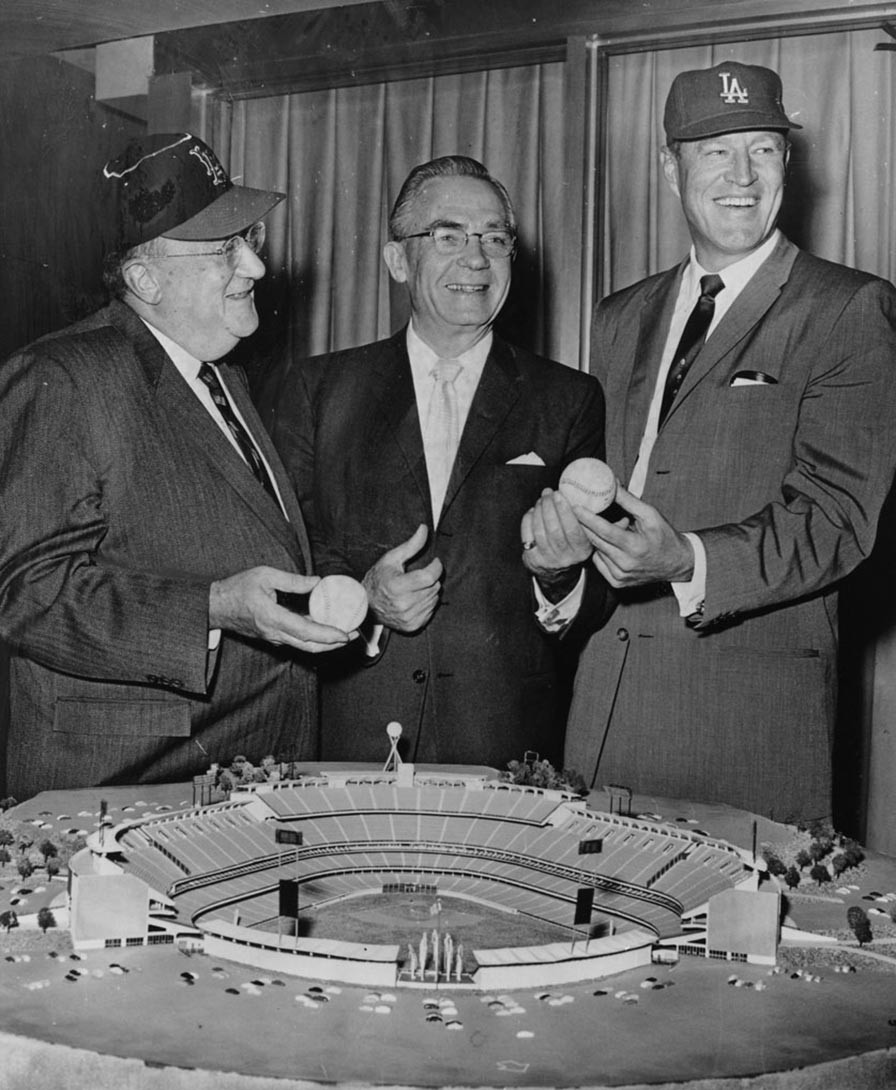
Walter O’Malley and Angels President Robert Reynolds trade hats in front of a model on Dec. 11, 1961. The Angels played at Dodger Stadium from 1962-65 before moving to Anaheim. In the center is Chad McClellan, who negotiated on behalf of the County and City of Los Angeles to bring the Dodgers to Los Angeles.
Courtesy of University of Southern California, on behalf of the USC Specialized Libraries and Archival Collections
The two aces of the Dodger pitching staff, Koufax and Drysdale decided to do something that had never been done before — to negotiate their contracts in tandem in the final week of February 1966. They wanted significant salary increases at a time when the average salary was about $30,000 and the minimum was $6,000. The mound men even hired prominent entertainment attorney J. William Hayes to represent them in the sometimes bitter negotiations standoff. O’Malley knew the serious nature of the negotiations, which he normally would rely on Executive Vice President and General Manager Buzzie Bavasi to resolve.
But, as time passed and the inflexible hurlers made it clear that they would just sit out and wait, that got the attention of O’Malley. He believed that the worst thing to do from a marketing standpoint was to bang the product. In the wacky world of the business of baseball, the product is the players. Thus, he could not very well bash the pitchers and then promote them, asking fans to come and spend money to watch them play. He had to take a smarter and higher road.
“No two players, before or since, negotiated jointly,” Bob Hunter, Daily News, June 29, 1984 (First of three-part series) said Hayes in a 1984 interview recalling the double holdout, after asking the Dodgers for $1 million to sign the pair for three years.
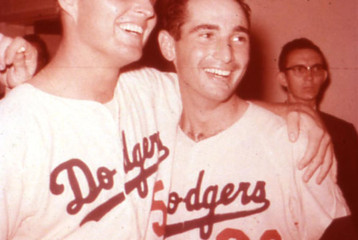
Don Drysdale and Sandy Koufax proved to be a formidable duo away from the pitcher’s mound when negotiating their contracts for the 1966 season.
Copyright © Los Angeles Dodgers, Inc.
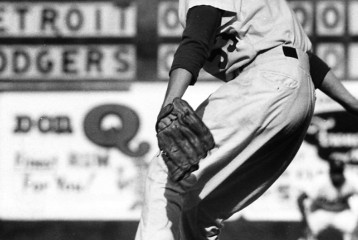
Southern California native Don Drysdale had a chance to come home when the Dodgers moved from New York in 1958.
Copyright © Los Angeles Dodgers, Inc.
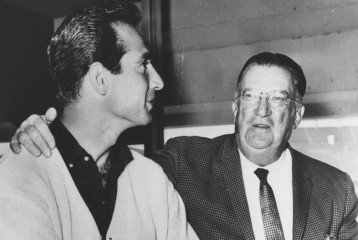
Walter O’Malley and Sandy Koufax, who won 27 games in his final season in 1966. Koufax would be elected as the youngest member ever to the Baseball Hall of Fame at the age of 36 in 1972.
AP Photo
Hayes drew upon the illegality of a personal-service contract in the movie business and applied the precedent in New York and California to sports. He told O’Malley, “We have an excellent chance to negate their contracts. If you want to test their validity in court, you will lose.” Bob Hunter, Daily News, June 30, 1984 (Second of three-part series)
Not wanting the negative publicity of a court fight, O’Malley met with knowledgeable friend and studio producer Mervyn LeRoy, as well as Dodger-turned-actor Connors to find out if there was a way of bringing this stalemate to a conclusion.
O’Malley acknowledged the tactic of united negotiations when he jokingly said, “The boys are showing some nice strategy coming in together. Charlie (Dressen) came alone...They are entitled to everything they can get out of Buzzie Bavasi. Their only problem is what Buzzie can get out of me.” Melvin Durslag, Los Angeles Herald-Examiner, March 12, 1966
Finally, after some marathon negotiations, the players agreed on March 30 to be compensated $125,000 for Koufax and $110,000 for Drysdale, making the duo the highest paid pitchers in baseball history at that time. It was a financial hit for O’Malley to agree to, but he also realized the talent-level of the pitchers was extraordinary and key to winning the 1966 N.L. Pennant. That is exactly what happened, as the two reported at the tail-end of spring training, as the team had already left its Dodgertown headquarters in Vero Beach and moved to Arizona for exhibition games. While their Dodger teammates embraced them with open arms after the holdout, the pair rounded into shape during the early part of the regular season. While Drysdale worked out at Van Nuys High School, his alma mater, Koufax had not even picked up a baseball since his Cy Young Award-winning 1965 season.
The 1966 Dodgers were a fine bunch of players, including such notable stars as Maury Wills, Wes Parker, Ron Fairly, Willie Davis, Tommy Davis, Jim Lefebvre, John Roseboro, Claude Osteen, Phil Regan and Perranoski. Koufax set an L.A.-record with 27 wins in 1966 and earned his third Cy Young Award. The Dodgers won 95 games and finished one and one-half games ahead to win their fourth N.L. Pennant since moving to Los Angeles. However, the pitching strong Baltimore Orioles overpowered the Dodgers in the 1966 World Series, sweeping them in four games and limiting them to just two total runs scored.
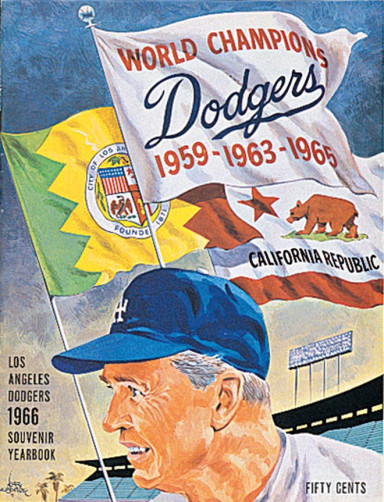
1966 Dodgers Yearbook
Copyright © Los Angeles Dodgers, Inc.
O’Malley realized that running a sports organization takes significant talent and personnel. Although his staff was not large by today’s standards, O’Malley felt that the best way to develop and prepare individuals to work in the business side of sports was to teach them. He had discussed this with his friend, Dr. James Mason and others in 1957. At that time, Dr. Mason was at the University of Florida, Coral Gables. By 1966, Dr. Mason had moved to Ohio University when he established the first degree-granting curriculum for sports administration. O’Malley has long been recognized for his foresight in this area, as thousands of students have graduated from this and other schools in sports administration programs, enabling them to move into the world of professional and collegiate teams with the background and tools necessary to succeed, instead of on-the-job training. In the dedication of his book, “Modern Sports Administration,” Dr. Mason wrote, “This book is dedicated to Walter O’Malley...whose creativity, vision, and foresight advanced the idea that sports administrators need academic preparation.” “Modern Sports Administration” by Dr. James G. Mason and Jim Paul, Prentice Hall, copyright 1988
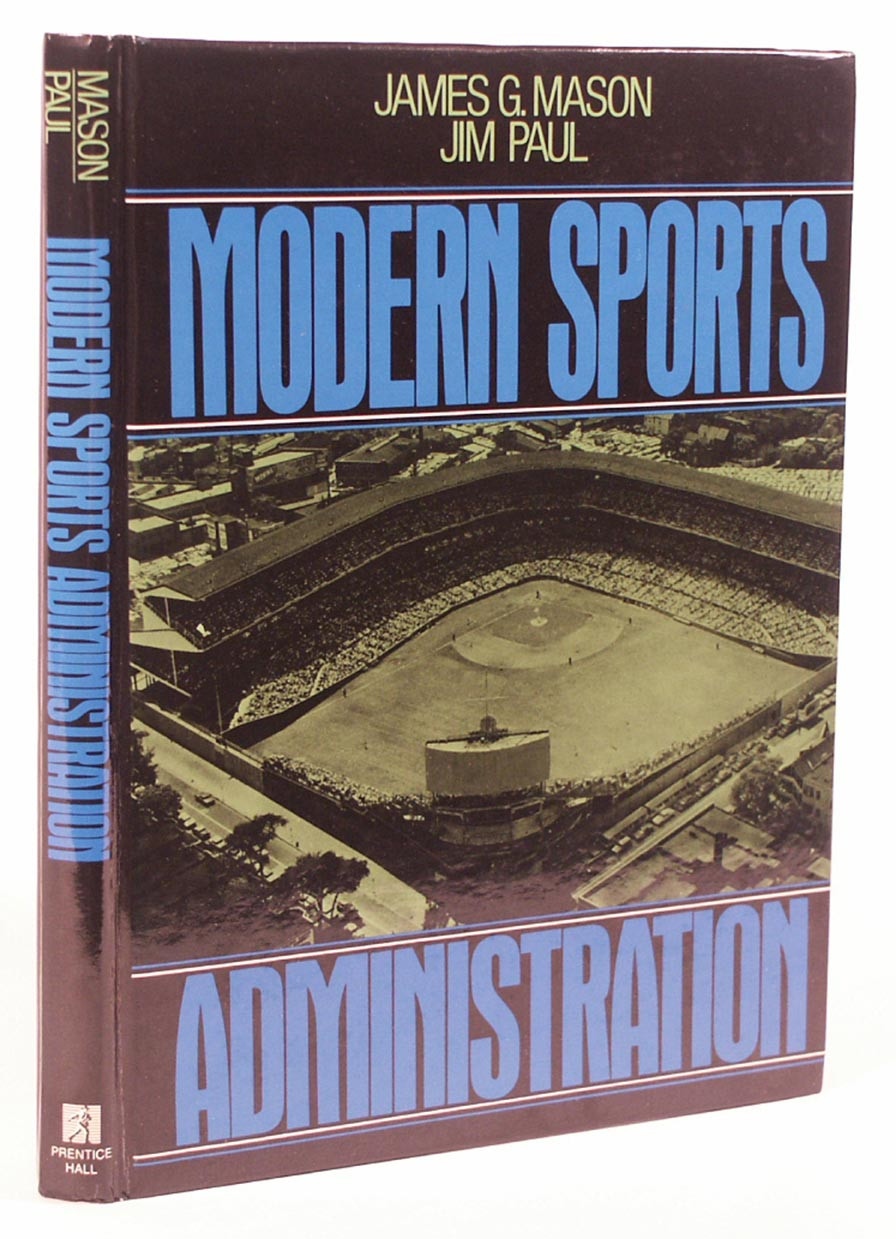
Walter O’Malley’s management style and foresight into educating and training personnel on the business side of sports was praised in the book “Modern Sports Administration”, which was dedicated to O’Malley by Ohio University professor Dr. James Mason.
To O’Malley, an employee’s ability to give his all and to do his job properly were the important factors in hiring. Ability also led to stability, a hallmark of O’Malley’s Dodger organization. O’Malley had just two managers, Hall of Famers Alston and Tommy Lasorda, from 1954-79. He had three General Managers — Buzzie Bavasi, Fresco Thompson and Al Campanis — during that period, as well. And only two farm directors, Thompson and William P. Schweppe and two scouting directors, Campanis and Ben Wade. In other words, loyalty, dedication and hard work meant something. O’Malley did not make changes with the manager, even when pressured to by outside sources, because it was his opinion that, if the team did not compete successfully, it was an entire organizational breakdown and the blame should not be shouldered by the manager alone.
O’Malley could not run a large organization like the Dodgers without the backbone of workers and a total team effort. He was blessed to have hired some of the most knowledge individuals in their respective fields. Behind-the-scenes names like Thompson, Bavasi, Campanis, Schweppe and Dick Walsh, plus top-notch scouts and coaches like Bert Wells, John Carey, Steve Lembo, Arthur Dede and Johnny Corriden helped to take on challenges and shape the Dodgers into winners on and off the field. An appreciative O’Malley thanked them for their input and for pulling together. Many dedicated scouts, coaches and minor league managers also had 20 to 30 years of service time working for the Dodgers. The Dodgers finished either first or second place in 12 of 19 seasons that he was at the helm (1951-69), including eight N.L. Pennants in 1952, 1953, 1955, 1956, 1959, 1963, 1965 and 1966. The Dodgers won World Championships in 1955, 1959, 1963 and 1965 under O’Malley. While serving as Chairman of the Board, the Dodgers won three more N.L. Pennants. No N.L. team won more games, more pennants or more World Series, or drew more fans than O’Malley’s Dodgers.
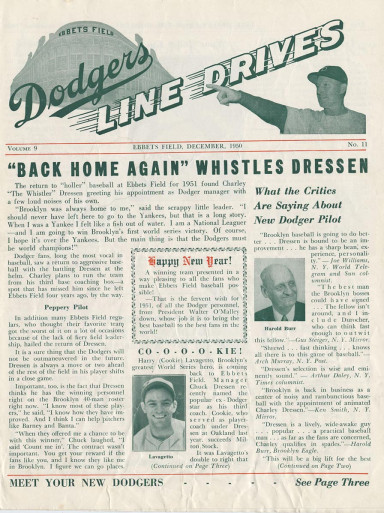
The Dodgers’ Line Drives newsletter, which dates back to their days in Brooklyn, was a popular publication for season ticket holders, as well as group and mail order fans. The newsletter included updated information on the organization. Shown is the first Line Drives from December, 1950 following Walter O’Malley being named club president.
Copyright © Los Angeles Dodgers, Inc.
The fans were a large part of his concern on a daily basis. He read letters from them, talked to them both at Dodger Stadium and elsewhere to feel the pulse of how his organization was being run and accepted. O’Malley sent regular year-round communications to his season, group and individual mail-order ticket purchasers, including the popular Line Drives newsletter. He also held the line on ticket prices, making Dodger baseball affordable to families, which he always encouraged to attend games. For 18 seasons, the Dodger ticket prices remained unchanged in Los Angeles. The Dodgers set records for attendance, breaking the Major League record in 1962 with 2,755,184. The Milwaukee Braves had gone over the two million barrier for four straight seasons in their new ballpark from 1954-57, after moving from Boston in 1953. The Dodgers would become the first Major League Baseball team to top the three million mark in attendance in 1978.

